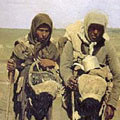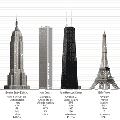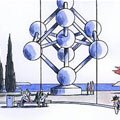eerste dag: aankomst in Cairo en vertrek naar Wadi al Natrun
De komende twaalf dagen hoop ik met een groep van twintig medepelgrims door Egypte te reizen. Het doel van deze pelgrimage is het doel van iedere pelgrimage: het zoeken van een diepere verbondenheid met Christus. Specifiek voor deze pelgrimage is dat we samen de oorsprong van het christelijke monasticisme gaan zoeken. Niet alleen als toeristen bezienswaardigheden bekijken, maar vooral ook, als volgelingen van Christus, de binnenkant van die bezienswaardigheden bezoeken. Zo God het wil, landen we vrijdagmiddag in Cairo en vertrekken dan direct naar het Makariosklooster in Wadi Natrun.

De reis kun je in vier etappes verdelen: Wadi Natrun (ten westen van de Nijldelta), Cairo, Rode Zee en Sinaï
Deir Anba Maqqar
It is common to allege that Wadi Natrun was the actual birthplace for Christian monasticism. This theory can be challenged by the theory that the Essenes of Palestine were the first Christians, and they practiced monasticism. The reason why the early Copts chose to install themselves out in the desert was more than piety. Under the Roman rule the Egyptian Christians were persecuted, especially around year 300, and many found refuge out of the cities. When Christianity became state religion in 330 Wadi Natrun was already firmly established as an important Christian centre, a place of piety. The piety would be lost over the centuries, and the monks would gradually become managers of their lands, benefiting from the work of the monastic serfs. In the 19th century, visitors to Wadi Natrun reported that the monks were lazy, dirty, immoral and of little education and manners.
There were at the most 50 monasteries here, most built according to the same pattern: fortresses with one or more churches inside, storerooms, a dining hall, kitchen, bakery and monks’ cells. Of these only 4 have survived into modern times. Some traveller’s guide books are quite scornful at the fact that most of what you will see at Wadi Natrun is not remotely close to its alleged age. Many of the buildings are really from the 19th and 20th centuries.
Bron: lexicorient.com
There were at the most 50 monasteries here, most built according to the same pattern: fortresses with one or more churches inside, storerooms, a dining hall, kitchen, bakery and monks’ cells. Of these only 4 have survived into modern times. Some traveller’s guide books are quite scornful at the fact that most of what you will see at Wadi Natrun is not remotely close to its alleged age. Many of the buildings are really from the 19th and 20th centuries.
Bron: lexicorient.com













